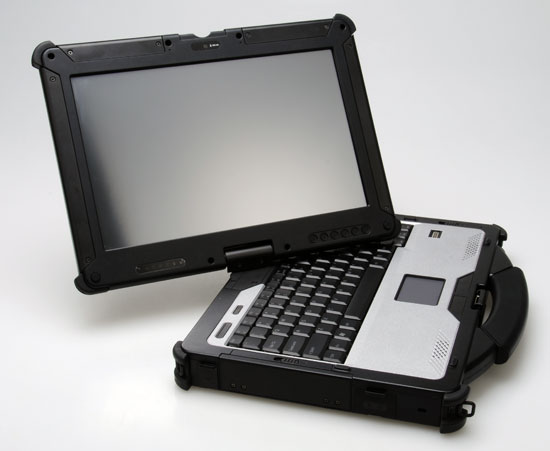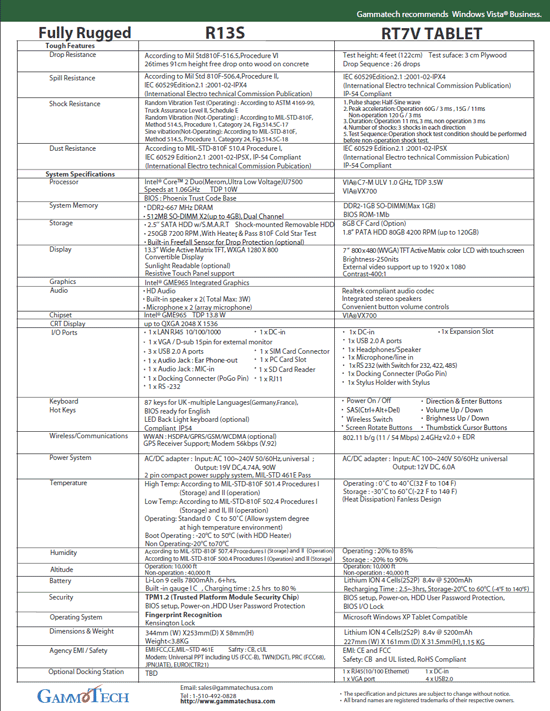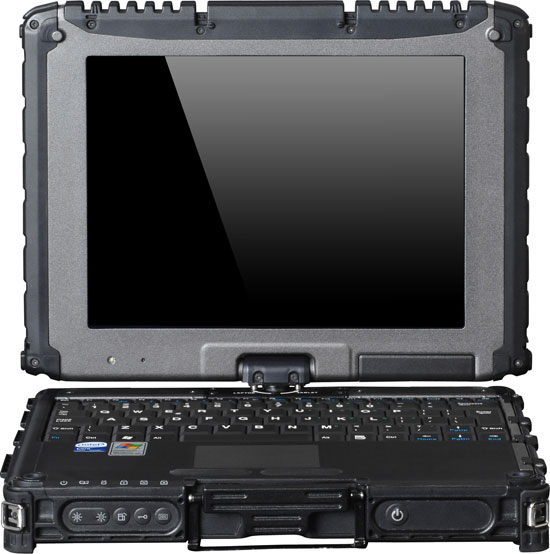To review or not to review: that is the question. As you might imagine, we get a lot of press releases sent our way, along with review opportunities. As the notebook reviewer, one product category I hear about on a regular basis -- from the vendors at least -- is ruggedized notebooks. For example, Getac and GammaTech both sent me press releases during the past couple weeks. This is not a category that we normally review, but I thought I would take this opportunity to ask you the readers whether or not you would be interested in seeing a review of this sort of system. There’s a poll below where you can answer, and as always you can leave a comment explaining your choice.
The press releases for these sorts of systems almost read like another language, and that’s saying something considering we routinely throw around acronyms and buzzwords here at AnandTech. MIL-STD 810F and IP54 standards for ruggedness? I suppose I could look up what those standards mean, but essentially they say these laptops can take a beating and withstand harsh environments without failing. I’m not even sure we’re equipped to test these things properly, at least in terms of ruggedness, as pounding on a laptop until it breaks and doing so in a repeatable manner is beyond the scope of our reviews. (Maybe we could take six months and run around in Iraq or Afghanistan, then report our results?) In that sense, the reviews almost write themselves: list the various standards a laptop meets, give the spec table, and we’re done. We would of course perform some standardized benchmarking, so we could find out what sort of differences there are in terms of display quality, battery life, and performance. So again, we ask: are ruggedized laptop reviews something you would like to see?

To go along with that question, here are some details about a couple recently announced ruggedized notebooks. First up we have the spec sheet from the GammaTech Durabook R13S/RTV7 (the focus is on the R13S, with the RTV7 being a tablet design).
 |
See what we mean about the various standards for ruggedness? Outside of the rugged aspect, however, it should also be readily apparent that these are not high-performance notebooks by any stretch of the imagination. The Core 2 Duo U7500 runs at a paltry 1.06 GHz. That should still outperform the Intel Atom processors (by a pretty wide margin in some cases), and it should help with battery life, but you wouldn’t want to do any CPU intensive work on such a slow system. We should also note that GammaTech appears to be first and foremost a supplier of government notebooks. Let’s take a look at another company that caters more to end-users rather than large businesses/corporations/governments.

Getac specializes in ruggedized notebooks and PDAs. They’ve recently updated their V100, which already included some interesting features. One item that immediately jumps out as being different from any other notebook I’ve ever tested is the LCD, with LED backlighting rated at up to 1200 nits! As a point of reference, that’s over four times brighter than the brightest notebook I’ve ever tested (the Dell Studio XPS 16) and over twice as bright as any desktop LCD I’ve tested. Brighter doesn’t necessarily mean better in terms of color accuracy and contrast ratio, but if you plan on working outside (in a bright desert environment as an example), a 1200 nits LCD would almost be required. Yes, I also have to wonder what that will do to battery life.
Most of the other upgrades correspond to the availability of newer parts -- bigger hard drives, 802.11n wireless, more RAM, and a faster processor. The original V100 supported up to a U7600 (1.2GHz, 2MB shared, 533FSB, 65nm) and the new version now supports the SU9400 (1.4GHz , 3MB shared, 800FSB, 45nm). ExpressCard is also available now. The complete press release for the updated Getac V100 follows. We expect pricing to be in the realm of $3000 or more, depending on options.
GETAC UPGRADES ITS POPULAR V100 NOTEBOOK/TABLET PC WITH SEVEN NEW PERFORMANCE ENHANCING FEATURES
Extra Memory, Storage, and Communications Upgrades Adds Performance to Fully-Rugged Mobile PC with Super Bright 1200 NITS LED Display
LAKE FOREST, CA. June 2, 2009 -- Getac Inc., a leading innovator and manufacturer of rugged computers that meet the demands of field-based applications, is upgrading its popular V100 fully rugged convertible with seven new features. The latest enhancements to Getac’s V100 fully rugged convertible include processor and memory upgrades, greater storage capacities and enhanced bandwidth and wireless capabilities.
“The V100 fully rugged convertible has been very popular because of its advanced feature set and super bright 1200 NITs screen,” said Jim Rimay, president, Getac, Inc. “With better performance, memory, storage and wireless capabilities, the new Getac V100 is more advanced and flexible as ever and even better suited for mobile field workers and users of rugged notebook PCs.”
The new performance enhancing features include a processor upgrade from 1.2 GHz Intel Merom to 1.4 GHz Intel Penryn. The front side bus has been increased from 533 MHz to 800 MHz; and the 2MB L2 cache has been increased to 3MB. Memory on the V100’s RAM has increased from 2GB to 4GB. Storage capacities have been increased from a minimum HDD of 120GB to a minimum of 160GB and a maximum capacity increase from 250GB to 320GB. In addition, the computer’s wireless networking capabilities have been upgraded to include draft 802.11n and the V100 now offers an ExpressCard slot in the standard configuration.
In addition, the Getac V100 has been UL 1604 certified by Underwriters Laboratories, an independent lab that tests products to ensure public safety. The optional UL 1604 certification allows safe, spark-free use of the V100 in potentially explosive environments typically found in the oil and gas, petrochemical, aviation and other industries.
The transformable Getac V100 features a swiveling LED screen for the ultimate in portability. It also features a Magnesium Alloy design, shock mounted hard disk drive and sealed I/O caps and doors to prevent damage from solid particles. Although it weighs a mere 4.9 pounds, the V100 is rough-and-tumble enough to withstand even the harshest working environments. It is fully compliant with MIL-STD 810F and IP54 standards for ruggedness including the ability to withstand heavy rain, airborne dust and debris. For further protection, the convertible notebook/tablet PC has a removable hard drive that is shielded by a special mechanism to prevent damage during operation; anti vibration compounds, which serve as a shock absorber during transport; and an anti-shock housing to further protect it if bumped or dropped.
The V100 also offers its Sunlight Readable Technology and can be upgraded to an industry-leading super-bright 1,200 NITs display, which provides unmatched outdoor viewability and screen brightness while decreasing reflectivity thus preserving battery life. Combined with an active anti-reflective process based on circular polarization to absorb reflective light, the V100’s Sunlight Readable Technology enables viewability that is more than six times better* than competing solutions and creates a mercury-free solution. Other features include 10/100/1000 Ethernet, integrated GPS and Bluetooth. It also features a waterproof keyboard and an SD card slot.
Okay, on to the poll that I mentioned earlier. There are two questions I want to ask, and they are not necessarily related. The first deals with ruggedized notebooks and whether you would like to see us review such a system (or systems). The second question deals more with laptops/notebooks in general. I’d just like to know specifically what type of laptops you are most interested in seeing us review, including ruggedized notebooks as an option. As always, feel free to leave a comment explaining your choices, particularly if our options don’t exactly match what you’re thinking.
{poll 132:575}









27 Comments
View All Comments
jediknight - Saturday, June 13, 2009 - link
I would be interested in seeing how mainstream laptops stack up - I suspect some may be much better than others.Alternatively, I'd like to see how suitable these ruggedized laptops are for mainstream, consumer use and situations - ie. could I put the laptop in checked luggage at the airport, and not worry about it? Are the screens bright enough for use outdoors in bright sunlight (all of the laptops I've had fail this miserably - it sucks needing to work inside on a nice summer day when there is no business need for it)
JohnMD1022 - Thursday, June 11, 2009 - link
There are already a number of sites covering this subject. Some are specializing in it.So why add to the clutter?
Flyboy27 - Tuesday, June 9, 2009 - link
Land Surveyors pops into my head immediately. They at least need a rugged PDA to capture data from their instruments. Also, security installers or anyone who works in the field and still needs more functionality than they can get from a smartphone. Maybe a plummer is down in a sewer and wants to look up a part. Or maybe I just want to check my email outside in the rain or next to the swimming pool.cazares - Tuesday, June 9, 2009 - link
Speaking from the perspective of someone who works everyday with mobile / ruggedized needs - I would welcome this. I can also say there may be a large audience of members (military, contractor, government service, etc) that view this site on a daily basis, myself being one of them, that maybe you don't know about. It surprised myself meeting others that were as geeky as myself in the profession I am (not necessarily a techy job).umbrel - Tuesday, June 9, 2009 - link
We pretty much don't know what is the value of it. You could address that:Other than reading in sunlight, you could take it to fishing/camping (star gazing?) and checking if it can be used onder rain/snow (are the buttons ok to use with gloves or even if the thing can take the weather you wont use it), can it survive sliping from a rock/dock and falling in the river/sea. You would probably have to ask what kind of accidents are common for the people that takes their laptops to those stuff (what their primary use seeing maps? I don't think anyone would play Farcry in a tropical jungle.
If there are some sort of common accidents compare how many normal laptops of similar performance would be wasted before a rugged one is cost effective.
I don't really think a rugged laptop is worth it other than in military situations (having to throw the thing in the car and hit the gas) as other poster mentioned.
soydios - Tuesday, June 9, 2009 - link
I see it this way: what would I rather see a review of, given the author's limited time available to write quality reviews? A simple line-by-line analysis of the spec sheet is not sufficient for a website like AnandTech; that belongs on DailyTech. I would rather see this site review products that consumers and readers are likely to buy, such as a tablet or thin-and-light laptop. A ruggedized laptop is not even lust-worthy like a gaming laptop is.ironique - Tuesday, June 9, 2009 - link
If you do decide to review ruggedized laptops, it'd be nice if you could look into Panasonic Toughbooks too.Willie11b - Tuesday, June 9, 2009 - link
I am currently assigned to Afghanistan and can assure you that there are real uses for these computers. Even with the rediculous prices. Hypothetically speaking: Let's say that you are out... somewhere ... and are working on an issue with the Afghan National Army. You have some resources on your laptop that are helpful (training materials etc..) Suppose that you are required to mount up IMMEDIATELY and toss your computer in your HMMWV and take off. Of course your standard laptop can handle a minute or two of bouncing around on the marvelous roads and a few hundred HOT 7.62 rounds dropping on it from your top gunner is OK too, but when the gunner steps on it, well $h!7... Anyway, if you want me to test out ruggedized laptops for you, let me know!!! I can hand out as many as you want to provide and see which one lasts longest. This is not exactly scientific testing but what the heck.Out!
ChuckDriver - Tuesday, June 9, 2009 - link
While I'm not likely to buy one, I'd love reading about them. The features that interest me most in ruggedized notebooks are the transflective LCDs and the cooling systems. I'd love to have a mainstream notebook with a display I could view in direct sunlight. If enough people adopt ruggedized notebooks with these displays, then economies of scale could be realized and possibly move them down to less expensive notebooks.Voldenuit - Monday, June 8, 2009 - link
Without a large baseline of reviews demarcating the state of the art (or at least, the market), individual product reviews are generally not particularly helpful or informative for consumers trying to pick out an outstanding product.If AT wants to be serious about reviewing notebooks, they need to get serious about it, to the scale of C|Net or NBR, but hopefully with the in-depth expertise that we associate and expect of AT.